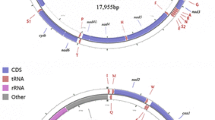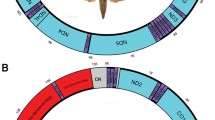Abstract
The bumblebee species,Bombus, is an invaluable natural resource for greenhouse pollination. Low levels of genetic variation ofBombus ardens have been reported in a previous mitochondrial (mt) gene study. In this study, we sequenced the complete internal transcribed spacer 2 (ITS2) of the nuclear rDNA obtained from 100B. ardens individuals collected from several Korean localities, in an effort to assess its usefulness in characterizing the genetic diversity and relationships among populations of B. ardens. The ITS2 sequences ofB. ardens were shown to be longest among known insects, ranging in size from 1,971–1,984 bp. The sequences harbor four duplicated repeats-≈27 bp repeats, ≈20 bp repeats, ≈33 bp repeats, and ≈34 bp repeats-which have never before been reported in other insect ITS2 rDNA. The maximum sequence divergence of 1.01% among 96 sequence types confirmed the applicability of this molecule to the study of intraspecific variation, revealing higher sequence variation as compared to the previously studied mt COI gene. Overall, a very high per generation migration ratio (Nm = 5.83 ≈ infinite) and a very low level of genetic fixation (FST =0 –0.08) were noted to exist among populations ofB. ardens. The high estimation of gene flow among most populations-in particular, between the remote island Ulleungdo and several inland populations-suggest that historical events may be more responsible for the contemporary population structure of B. ardens. The finding of the lowest genetic diversity (π) in the population on Ulleungdo Island (π = 0.007434) may be reflective of a relatively small population size and the geographical isolation of the population as compared with other inland populations.
Similar content being viewed by others
References
Akaike H (1974) A new look at the statistical model identification. IEEE Trans. Autom. Contr. 19: 716–723.
Alam MT, Bora H, Das MK andSharma YD (2008) The type and mysorensis forms of theAnopheles stephensi (Diptera: Culicidae) in India exhibit identical ribosomal DNA ITS2 and domain-3 sequences. Parasitol. Res. 103: 75–80.
Arnheim N (1983)Concerted evolution of multigene families, Evolution of Genes and Proteins. Nei M. and Koehn R.K., eds., Sinauer, Sunderland, MA, pp. 38–61.
Beebe NW, Ellis JT, Cooper RD andSaul A (1999) DNA sequence analysis of the ribosomal DNA ITS2 region for theAnopheles punctulatus group of mosquitoes. Insect Mol. Biol. 8: 381–390.
Benson G (1999) Tandem repeats finder: a program to analyze DNA sequences. Nucleic Acids Res. 27: 573–580.
Boileau P, Walch G andLiotard JP (1992) Radio-cinematographic study of active elevation of the prosthetic shoulder. Rev. Chir. Orthop. Reparatrice Appar. Mot. 78: 355–364.
Castresana J (2000) Selection of conserved blocks from multiple alignments for their use in phylogenetic tool. Curr. Opin. Genet. Dev. 8: 669–674.
Chapman RE andBourke AFG (2001) The influence of sociality on the conservation biology of social insects. Ecol. Letters 4: 650–662.
Collins FH andPaskewitz S (1996) A review of the use of ribosomal DNA (rDNA) to differentiate among crypticAnopheles species. Insect Mol. Biol. 5: 1–9.
Corbet SA, Williams IH andOsborne JL (1991) Bees and the pollination of crops and wild flowers in the European Community. Bee World 72: 47–59.
Darvill B, Ellis JS, Lye GC andGoulson D (2006) Population structure and inbreeding in a rare and declining bumblebee,Bombus muscorum, (Hymenoptera: Apidae). Mol. Ecol. 15: 601–611.
De la Rúa P, de May-Itzá JW, Serrano J andQuezada-Euán JJG (2007) Sequence and RFLP analysis of the ITS2 ribosomal DNA in two Neotropical social bees,Melipona beecheii and Melipona yucatanica (Apidae, Meliponini). Insectes Sociaux 54: 418–423.
Ellis JS, Knight ME, Darvill B andGoulson D (2006) Extremely low effective population sizes, genetic structuring and reduced genetic diversity in a threatened bumblebee species,Bombus sylvarum (Hymenoptera: Apidae). Mol. Ecol. 15: 4375–4386.
Estoup A, Solingac M, Cornuet JM, Goudet J andScholl A (1996) Genetic differentiation of continental and island populations ofBombus terrestris (Hymenoptera: Apidae) in Europe. Mol. Ecol. 5: 19–31.
Excoffier L, Laval G andSchneider S (2005) Arlequin ver. 3.0: An integrated software package for population genetics data analysis. Evolutionary Bioinformatics Online 1: 47–50.
Excoffier L, Smouse PE andQuattro JM (1992) Analysis of molecular variance inferred from metric distances among DNA haplotypes: application to human mitochondrial DNA restriction data. Genetics 131: 479–491.
Frankham R (1996) Conservation Genetics. Ann. Rev. Genet. 29: 305–327.
Fritz GN, Conn J, Cockburn A andSeawright J (1994) Sequence analysis of ribosomal DNA internal transcribed spacer 2 from populations ofAnopheles nunezyovari (Diptera: Culicidae). Mol. Biol. Evol. 11: 406–416.
Gómez-Zurita J, Juan C andPetitpierre E (2000) Sequence, secondary structure and phylogenetic analyses of the ribosomal internal transcribed spacer 2 (ITS2) in theTimarcha leaf beetles (Coleoptera: Chrysomelidae). Insect Mol. Biol. 9: 591–604.
Hackett BJ, Gimnig J, Guelbeogo W, Constantini C, Koekemoer LL, Coetzee M, Collins FH andBesansky NJ (2000) Ribosomal DNA internal transcribed spacer (ITS2) sequences differenciateAnopheles funestus andA. rivulorum, and uncover a cryptic taxon. Insect Mol. Biol. 9: 369–374.
Hartl DL andClark AG (1989)Principles of Population Genetics. Sinauer Associates, Inc., Sunderland, MA.
Huelsenbeck JP andRonquist F (2001) MrBayes: Bayesian inference of phylogeny. Bioinformatics 17: 754–755.
Ji Y, Zhang D andHe L (2003) Evolutionary conservation and versatility of a new set of primers for amplifying the ribosomal internal transcribed spacer regions in insects and other invertebrates. Mol. Ecol. Notes 3: 581–585.
Katoh K, Misawa K, Kuma K andMiyata T (2002) MAFFT: a novel method for rapid multiple sequence alignment based on fast Fourier transform. Nucleic Acids Res. 30: 3059–3066.
Keller A, Schleicher T, Schultz J, Müller T, Dandekar T andWolf M (2009) 5.8S-28S rRNA interaction and HMM-based ITS2 annotation. Gene 430: 50–57.
Kim MJ, Yoon HJ, Im HH, Jeong HU, Kim MI, Kim SR andKim I (2009) Mitocondrial DNA sequence variation of the bomblebee,Bombus ardens (Hymenoptera: Apidae). J. Asia-Pacific Entomol. 12: 133–139.
Kimura M (1980) A simple method for estimating evolutionary rate of base substitution through comparative studies of nucleotide sequences. J. Mol. Evol. 16: 111–120.
Marcilla A, Bargues MD, Ramsey JM, Magallon-Gastelum E, Salazar-Schettino PM, Abad-Franch F, Dujardin JP, Schofield CJ andMas-Coma S (2001) The ITS-2 of the nuclear rDNA as a molecular marker for populations, species and phylogenetic relationships in Triatominae (Hemiptera: Reduviidae), vectors of Chagas disease. Mol. Phyl. Evol. 18: 136–142.
Marinucci M, Romi R, Mancini P, Di Luca M andSeverini C (1999) Phylogenetic relationships of seven palearctic members of the maculipennis complex inferred from ITS2 sequence analysis. Insect Mol. Biol. 8: 469–480.
Mikkola K (1978) Spring migrations of wasps and bumble bees on southern coast of Finland (Hymenoptera Vespidae and Apidae). Ann. Entomol. Fennici 44: 10–26.
Miller BR, Crabtree MB andSavage H (1996) Phylogeny of fourteen Culex mosquito species including the Culex pipines complex, inferred from the internal transcribed spacer of ribosomal DNA. Insect Mol. Biol. 5: 93–107.
Mukabayire O, Boccolini D, Lochouarn L, Fontenille D andBesansky NJ (1999) Mitochondrial and ribosomal internal transcribed spacer (ITS2) diversity of the African malaria vectorAnopheles funestus. Mol. Ecol. 8:289–2977.
Posada D andCrandall KA (1998) MODELTEST: testing the model of DNA substitution. Bioinformatics 14: 817–818.
Swofford DL (2002) PAUP*. Phylogenetic Analysis Using Parsimony (*and Other Method) ver. 4.10., Sunderland. MA: Sinauer Associates.
Vobis M, Haese JD, Mehlhorn H, Mencke N, Blagburn BL, Bond R, Denholm I, Dryden MW, Payne P, Rust MK, Schroeder I, Vaughn MB andBledsoe D (2004) Molecular phylogeny of isolates ofCtenocephalides Felis and related species based on analysis of ITS1, ITS2 and mitochondrial 16S rDNA sequences and random binding primers. Parasitol. Res. 94: 219–226.
Vogler AP andDe Salle R (1994) Evolutionary and phylogenetic information content of the ITS1 region in the tiger beetleCicindela dorsilas. Mol. Biol. Evol. 11: 393–405.
Weekers PHH, De Jonckheere JH andDumont JH (2001) Phylogenetic relationships inferred from ribosomal ITS sequences and biogeographic patterns in representatives of the genus Calopteryx (Insecta: Odonata) of the West Mediterranean and adjacent West European zone. Mol. Phyl. Evol. 20: 89–99.
Widmer A andSchmid-Hempel P (1999) The population genetic structure of a large temperate pollinator species Bombus pascuorum (Scopoli) (Hymenoptera: Apidae). Mol. Ecol. 8: 387–398.
Williams PH (1994) Phyolgenetic relationships among bumblebees (Bombus Latr.): a reappraisal of morphological evidence. Syst. Entomol. 19: 327–244.
Wörheide G, Hooper JN andDegnan MB (2002) Phylogeography of western pacific Leucetta ‘chagosensis’ (Porifera: Calcarea) from ribosomal DNA sequences: implications for populations history and conservation of the Great Barrier Reef World Heritage Area (Australia). Mol. Ecol. 11: 1753–1768.
Author information
Authors and Affiliations
Corresponding author
Additional information
#These authors contributed equally to this paper.
Rights and permissions
About this article
Cite this article
Oh, H.K., Yoon, H.J., Kim, M.J. et al. ITS2 ribosomal DNA sequence variation of the bumblebee,Bombus ardens (hymenoptera: Apidae). Genes & Genomics 31, 293–303 (2009). https://doi.org/10.1007/BF03191202
Received:
Accepted:
Issue Date:
DOI: https://doi.org/10.1007/BF03191202




